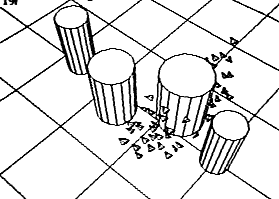To give a heads up, the social forces model is an agent based model that simulates the microscopic movements of pedestrians. The motion of these pedestrians are described by subjecting them to 'social forces'. These forces are exerted by the pedestrians personal environment, as well as the interactions with other pedestrians in this context.
The movement of these pedestrians governed by these social forces are defined by the equation below:
If you'd like more details on the paper, it can be found here
An example of a social forces simulation model can be seen running in this video below:
Now, with this BBC episode, you can check out this model in a real world example with the help of an experiment with human participants, where you can see the effect of jams during an evacuation in a potential real world situation, and how a very simple solution of placing an obstacle at the exit can actually improve the flow of people through a door when evacuating a building. Although, your intuition I'm sure would say that it would not make sense. Actually, as this obstacle separates the flow of people, it prevents a jam occuring at the door, and therefore, creates a smoother flow through the door. Have a look, it's available for another 10days, and the experiment runs from around the 24 min mark, UK users only I'm afraid:
BBC Bang goes the Theory S6 Ep 4
Enjoy!


